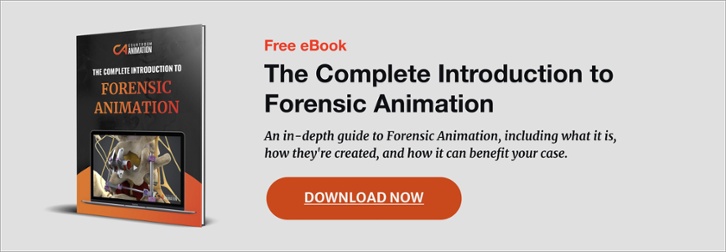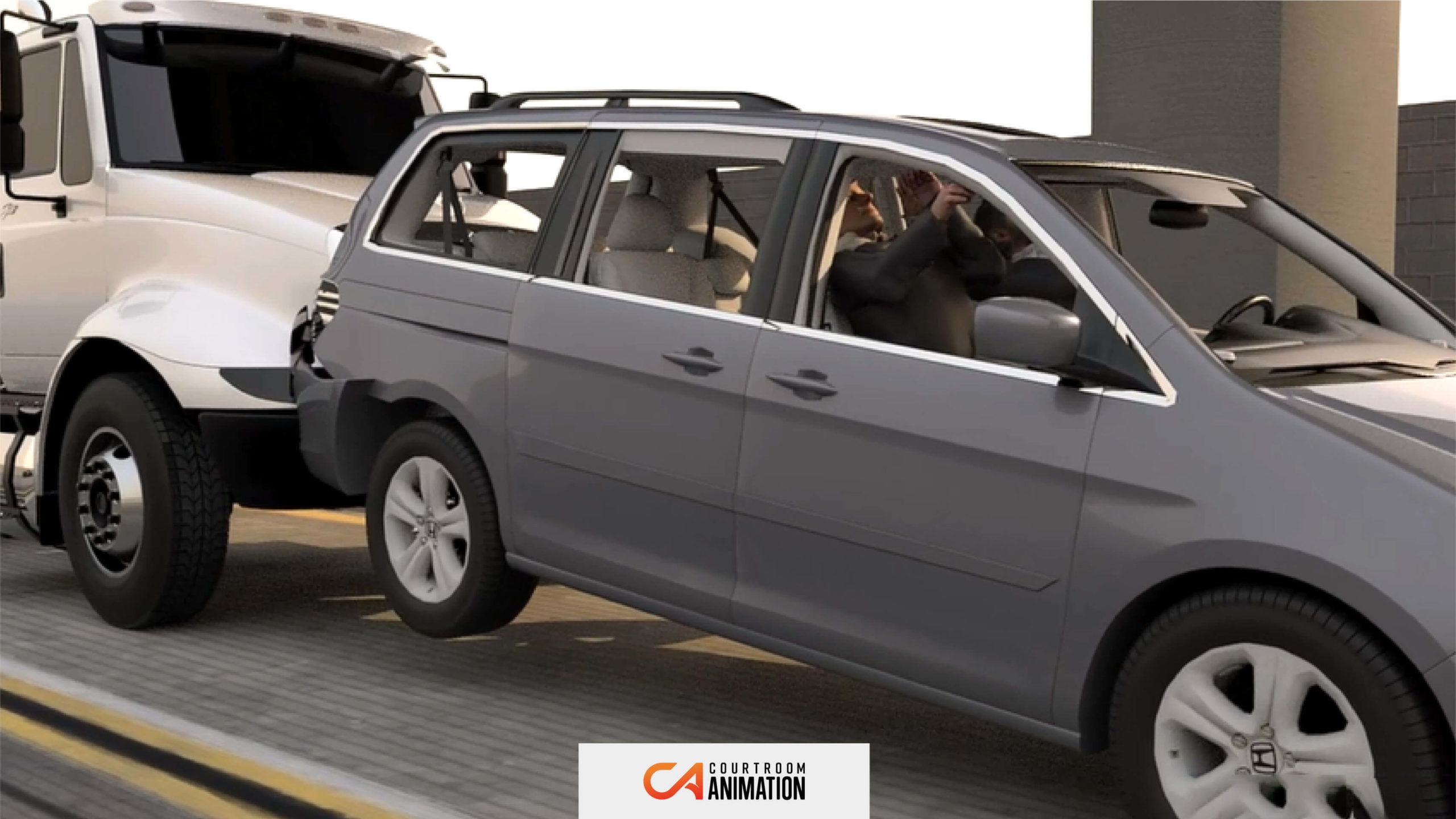
There are countless television shows, movies, and books about attorneys and their cases. One scene might show an attorney persuasively talking about their case, and then show them an image that makes the room erupt in whispers. Take the famous scene in To Kill a Mockingbird, during Atticus Finch’s closing argument against the jury – it is powerful, and ends with the camera panning to the stunned court.
In truth, cases rarely go to trial. When they do, they take a lot of preparation and time. During litigation, the crux of your case is not an emotional speech, but a compelling narrative backed by evidence.
Specifically, demonstrative evidence.
Different from real evidence, demonstrative evidence equips civil attorneys with the power of visual narratives to achieve multi-million dollar verdicts. This type of evidence is not fabricated or “cartoonish,” they are required by law to be accurate visualizations for purposes of admissibility.
Demonstrative evidence encompasses timelines, charts, medical diagrams, right-way wrong-way car crash animations, mechanisms of injury animations, and a multitude of other legal visuals.
Car Crash Animation That Helped Land a $1M Settlement – a 20x ROI.
But what can demonstrative evidence actually accomplish for you, your client, and your case? On our blog, we’ve talked at length about how demonstratives can increase retention, improve persuasion, and enhance your expert’s testimony/deposition.
But most importantly, when used to support your expert testimony by working with an expert forensic animation firm, demonstrative evidence can actually have a measurable Return on Investment (ROI) for you and your client. Read on to understand how – including real-world examples of the ROI demonstrative evidence has been delivered.
The ROI of Demonstratives for Plaintiff Attorneys
For a plaintiff attorney, assessing the potential ROI on investments into your client’s case can be challenging. Since plaintiff attorneys are typically compensated on contingency fee, you want to ensure the money you invest leads to a larger settlement or verdict. Otherwise, that investment you made may eat into your client’s much needed compensation – not to mention your own compensation.
The calculation for evaluating the return on investment for any exhibit, expert, or other legal service would be:
Increased Verdict or Settlement Amount / Cost of Investment x 100%
In other words, if you spent $25,000 on an animation that delivered an additional $250,000 in settlement, your ROI would be 1000% or 10x.
If only it were as simple as being able to say with confidence that any investment you make into your case directly translated into revenue, right?
Well, from our work over the years, we have served thousands of plaintiff attorneys who have been able to directly measure their returns from the use of other visual exhibits. Let’s look at some examples, in both trial and mediation.
Mediation
Avoiding trial has many benefits, primarily cost and time savings. One of the most effective ways to avoid trial and ensure a maximum settlement offer – is to leverage highly impactful and accurate visuals.
For example, in an accident reconstruction case involving a rear-end collision on a Southern California freeway, two plaintiffs suffered severe injuries when a semi-trailer crashed into them. The defense was holding firm on its settlement offer of $450K. Conflicting reports and accounts from both parties as to the severity of the incident lead to weeks of ‘back and forth.’
“The forensic animations were a game-changer that helped us receive a $1 million dollar settlement. Courtroom Animation’s team also worked within our tight deadline to deliver them within a two-week period!”
– Brad Wallace, Attorney & Founder of The Wallace Law Firm
To avoid going to trial, the plaintiff attorney reached out to our forensic animation studio. Working with his experts, we created three car crash animations from various perspectives including of the plaintiff’s during the crash – the foundations for the accident reconstruction included:
- Reference photos after the incident
- Testimony from both parties
- Crash data
- Traffic collision reports
Once the visuals were completed and viewed by both parties, the defense counsel raised their offer to $1 million. The visuals demonstrated the plaintiff team’s preparedness to go to trial, and convinced the defense that the risk of pursuing the case further was too high. This was a $550,000 increase from the original settlement offer – an over 20x return on investment!
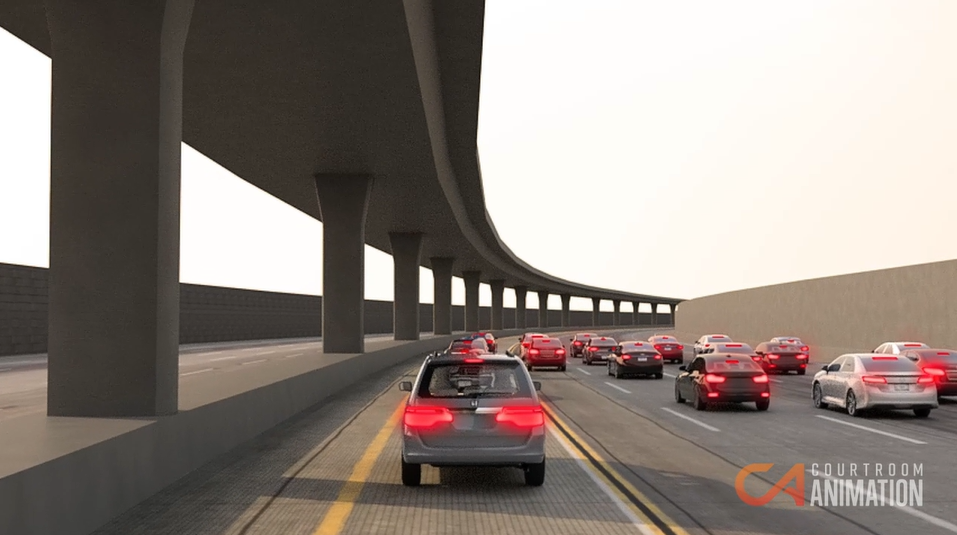
Rear-View Driver Perspective Still from Motor Vehicle Collision Animation – $1M Result Case
Plaintiff attorneys can also use demonstrative evidence to reach a high ROI on their injury or medical malpractice cases. When two plaintiff attorneys, Michael Greico and Stephan Blandin at the Romanucci & Blandin law firm, showed the mediator and the defense counsel their medical animation during settlement discussions, the defense settled in one day for $8 million.
The ROI of the medical graphics and animation paid for itself and (much) more.
Medical Legal Graphics That Led to $8M Settlement
Trial
Despite what people see on CSI, television is not a realistic trial environment. They usually focus on the latest legal technology and dazzle the audience with fancy gadgets. Unfortunately, in litigation, these expectations now extend to jurors in the courtroom – they expect that attorneys will use visuals and technology in an engaging way.
To increase the jury’s verdict amount in any case, the key is to create a visual narrative aid around your client.
Why? In negligence law, visible injury has historically been more compensable than less visible, often invisible emotional distress.
“Our judges and juries have generally given greater weight to visual evidence (in the form of both writings and exhibits) than to oral evidence.”
– Ashley S. Lipson, Art of Advocacy: Demonstrative Evidence 2.02 (1994)
When plaintiff attorneys draw empathy for their client through storytelling, the jury is more likely to provide a higher verdict. Thus, a trial demonstrative or other form of admissible visual would have a high ROI in court.
As one specific example, one of Erika Bright’s, a plaintiff attorney at Wick Phillips, case made it to trial. Her client, a 30,000-ton hydraulic press company, had a malfunctioning hydraulic press. Their insurance company refused to cover the cost of repair.
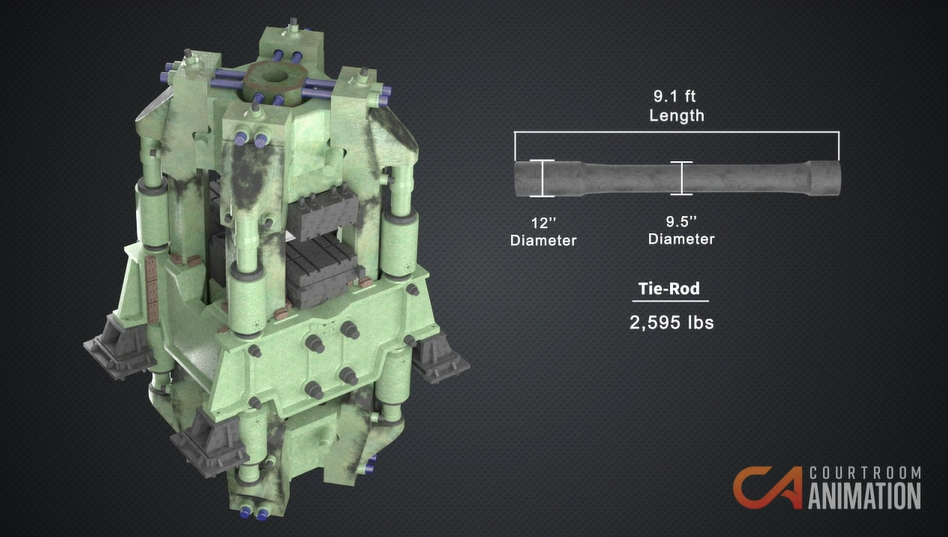
Demonstrative Exhibit of Press Failure from Courtroom Animation
The jury likely would not have understood how the press malfunctioned without a detailed visual and a technical expert to walk them through it.
By leveraging the demonstrative evidence at trial, the insurance company was determined to be fully liable. As a result, the jury awarded the plaintiff counsel a $44 million verdict for their client.
This is an astounding ROI for just one piece of demonstrative evidence!
The ROI of Demonstratives Exhibits for Defense Attorneys
Insurance companies benefit massively from demonstrative exhibits, reducing financial loss and expediting any claims process. The value provided by demonstrative exhibits for defense attorneys is identical to those of plaintiffs; however the expected return is inverse to that of a plaintiff.
Rather than focusing on an increase in the settlement or verdict, defense attorneys are focused on how they can reduce their client’s liability, in other words:
Amount Verdict or Settlement is Reduced / Cost of Investment x 100%
Simply put, if a demonstrative that costs $25,000 could reduce your client’s liability from $250,000 to $0, or even from $500,000 to $250,000 – then it would deliver an ROI in your case.
Let’s look at some concrete examples of this in action from the defense’s point of view.
Mediation
One of the advantages of animation is that, since it’s a recreation, it allows a legal party to showcase events even when there are multiple data sets and parties involved.
One civil case consisted of a plaintiff driver who entered a sandstorm on a highway, and collided with another vehicle. The municipality was sued for liability regarding excessive sand on the highway, and they had four experts weighing in during mediation.
The defense counsel, led by Jesse Cox, Partner at Lynberg Watkins, partnered with our team of animators to combine four experts data sets:
- Accident reconstructionist
- Forensic meteorologist
- Environmental scientist
- Human factors expert
Sample Demonstrative in Court from Courtroom Animation
The result was a digestible car crash animation put together with information from the four sources for the mediator and other parties. It resulted in a highly favorable, but confidential, defense verdict that came from an 8-figure demand.
In mediation, visuals can help demonstrate how the plaintiff was partially liable or how their case is inaccurate. The above case is evidence of how even one animation can make the difference towards a large settlement or a much more favorable one for the defense.
When you have hundreds of thousands or even millions of dollars on the table, the cost of an animation can pale in relation to the potential impact it can have.
Trial
Unlike mediation, trial is all about telling your side of the story. That’s why having a trial demonstrative is a valuable investment – it provides the jury the context they need to make a fully-informed verdict.
“A case, when presented only as a set of facts, is as good as lost.”
– Carl Bettinger, Twelve Heroes, One Voice: Guiding Jurors to Courageous Verdicts
In a trial that consisted of a car crash between a police officer and civilians, the defense counsel of Lynberg & Watkins had their work cut out for them. The attorneys needed to visualize how the defendant was not liable because all of the proper protocols had been met, such as how the vehicle slowed down at the intersection and had the police lights flashing.
They took advantage of trial demonstratives, using black box data and other physical data, to ensure that the plaintiff counsel’s objections were denied. The traffic accident animation was presented in their closing statements.
During deliberations, the jury evaluated the plaintiff counsel’s demand of $20 million…and announced a 100% defense verdict.
That one animation contributed to potentially millions in dollars of savings for the defense, at a fraction of the cost.
ROI of Demonstratives in Criminal Cases
Much of this article has focused on civil cases, where the ROI is easily measurable in dollars.
Criminal cases bring a totally different perspective, but still offer an ROI in the sense that justice – and someone’s life – is being litigated.
For prosecutors, demonstrative evidence can make or break the case by helping demonstrate key concepts from the case and ensure that the burden of proof is met. This can be essential to informing a jury and ensuring the maximum punishment for a crime.
And for criminal defense attorneys, demonstrative evidence can help explain or justify the defendant’s actions, help create doubt as to whether the defendant committed the actions, and more. Visuals that result in an acquittal or significantly less time in prison for your client can be truly invaluable.
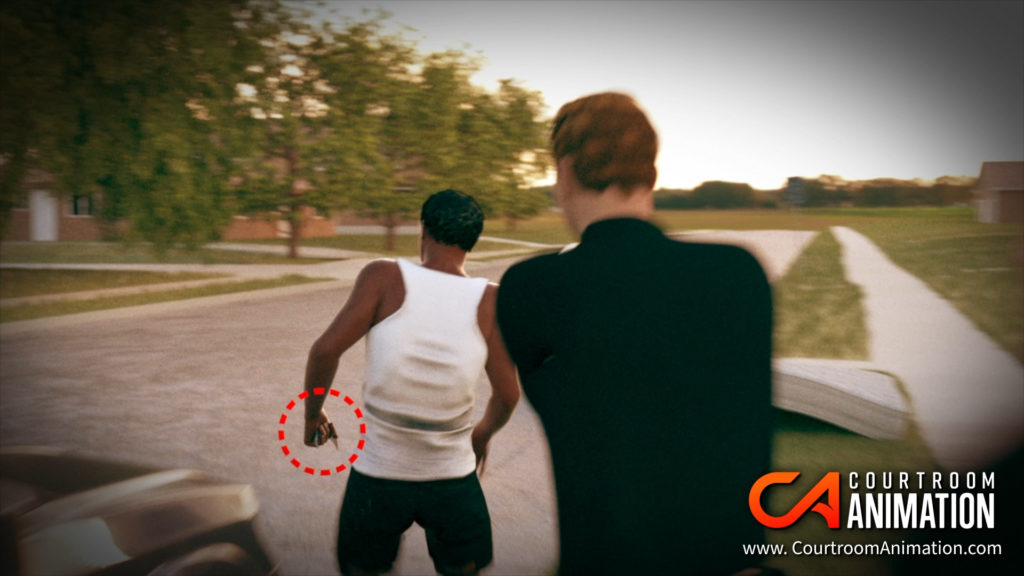
For example, one high-profile criminal case we worked on involved a police officer shooting a man after a physical altercation. The case sparked a national outcry, as it involved a white police officer shooting an African American man.
The contentious issue at play was whether the officer was justified in his actions, as it was unclear from cell phone footage of the scene whether the victim was wielding a weapon.
Our team was contracted by Brendan Matthews, a defense attorney at Cermele & Matthews, to use forensic analysis of the potential objects from the video evidence to determine what objects the man could have been holding. In the end, we went through a meticulous process to identify what the object was, and no charges were filed against the defendant.
How Much Do Demonstratives Cost?
There are truly demonstratives for every budget. And as explained earlier, your audience – whether it’s a mediator or jury – has been exposed to visuals in today’s modern era, and has an inherent bias toward expecting them.
Attorneys can meet this expectation with a visual that fits their case’s narrative. Mediation graphics or trial animations can be created with your needs and budget in mind.
A visual can truly make or break your case – but they can be created without breaking the bank.
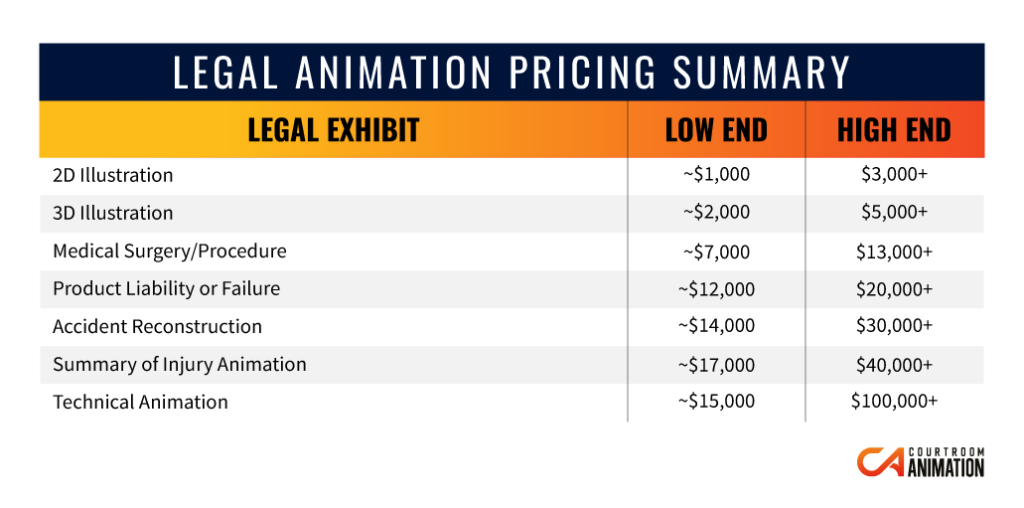
Sample Pricing Chart from Courtroom Animation’s Forensic Animation Pricing Guide.
Download your free copy for more information.
Demonstratives in Court or Mediation Can Be a Game-Changer
If an image is worth a thousand words, then demonstrative evidence could be worth millions of dollars.
For plaintiffs, a demonstrative in court can help the jury determine liability favorable to your case. Visuals are a crucial tool for attorneys, and can provide an ROI in the millions of dollars for mediation or trial.
After reviewing these cases, is it possible to answer the question of, “Is there a reasonable ROI for this type of evidence that will make it worth your time and effort?”
The attorneys featured in this article would say yes.
Courtroom Animation has created demonstrative evidence for over 2,000 cases, and helped attorneys achieve over $1 billion in results.
Get a free consultation with one of our experts now, to learn if animation could deliver an ROI for your case.
